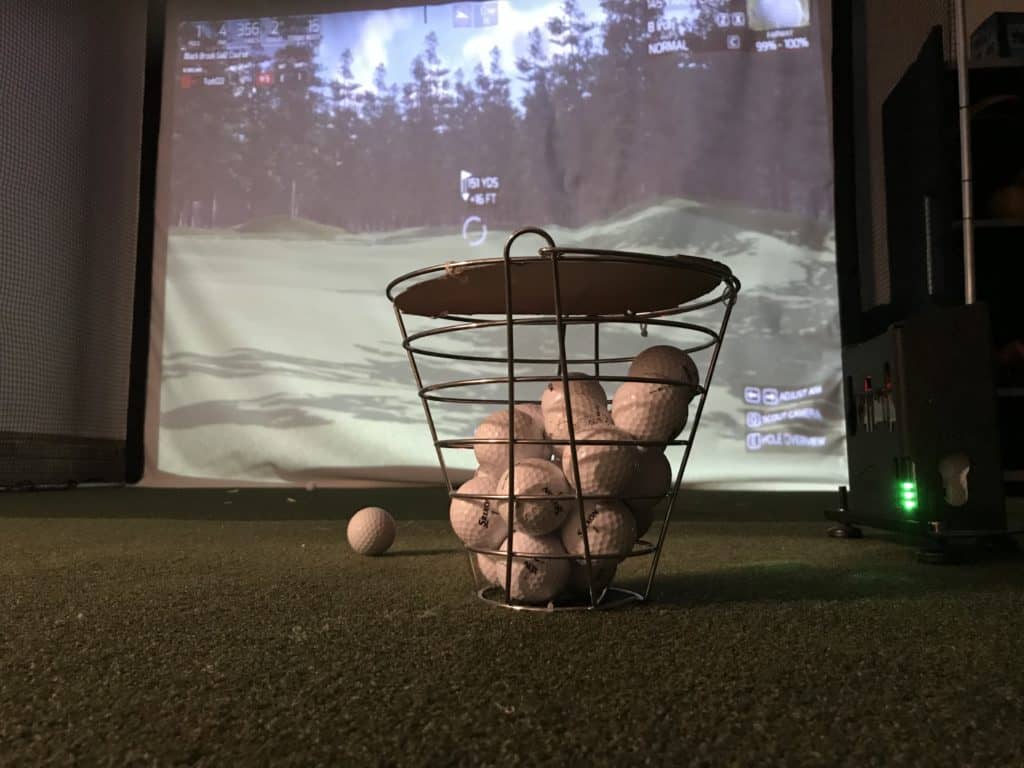The key is to make solid contact with every swing, control your start line and have precision in the carry distances. Once you can accomplish these three items, you are on your way to playing better golf and shooting better scores.
When you have a pitching wedge in your hand, not only should you be able to hit the green, but you should have an quality opportunity to make the putt on your next shot.
The pitching wedge is one of the most versatile clubs in the bag. It can be used from multiple distances and chip and pitch shots around the green.
Ensuring that you have the right pitching wedge for your game is important. I carry a 48 degree pitching wedge, which is pretty standard as far as loft is concerned. Most pitching wedges will vary in loft between 46 and 48 degrees.
The fastest two ways to get decrease your score in golf are the following:
- Improve your golf game from 125 yards and in.
- Increase your swing speed.
Today, we focus on improve your golf game from 125 yards and in and the pitching wedge plays a major role in your journey from this distance and closer to the hole.
Below, I will dive into everything related to the pitching wedge and touch on the following topics.
- The full shot pitching wedge
- The less than full shot pitching wedge
- The chip or pitch shot with the pitching wedge
How To Use A Pitching Wedge
Update: The pitching wedge should be viewed as a scoring club. Keep working on quality contact, start line control and curve control. Once you dial in those distances, you will make more birdies. Give yourself plenty of opportunities from 15 and closer!
Below, I will help you get better in these three areas with the full shot, the less than full shot and the chip or pitch shot with the pitching wedge.

The Full Shot Pitching Wedge
Most golfers will use the full shot with the pitching wedge somewhere between the 100 to 135 yard range. As you are getting closer to the green, maybe after a nice powerful drive, it is important to not only hit the green, but to hit the shot within 25 feet and on occasion much closer.
Tip #1: Make Solid Contact
The key to making solid contact with the pitching wedge or any club in the bag is controlling the low point in the golf swing. This starts with ensuring that at impact, you have enough weight or pressure on the front side. The golfer that gets stuck back and can’t control the low point will hit the thin or fat shot due to casting the club or having to make compensations at impact.
Drill: Low Point Control Drill
Here the the steps to take to complete this drill:
- Paint a 2-3 yard long line with some yard paint.
- Place a golf ball or wiffle ball on the line.
- The goal is to have your divot start just on the target side of your line.
- Go ahead and hit shot after shot, working on controlling your low point and your entry into the ground.
- Assess your success rate out of 20 times and write it down.
- Complete this drill daily for several weeks and see if your game improves at the course.
If you start to hit the ball poorly at any point on your golf journey, return to this drill and keep it simple.
One quick tip: if you are struggling to control your low point, go ahead and set up with 60% of your weight on your front leg. Keep your head centered without a big shift off the ball and turn more around your front leg.
This will help keep your centers in place and allow you to control the low point. Many golfers struggle with the low point because they don’t get their weight back to their front side early enough and end up casting the club.
This drill will help you develop the low point control in the golf swing needed for your pitching wedge and the many other clubs in your bag. This is a great drill to return to if your ball striking becomes inconsistent. It is a basic drill that can be completed in different locations and even without a golf ball.
Resource: Pitching Wedge Loft: Make Sure You have the right Loft!
Tip #2: Control The Start Line
Being able to control the start line is essential to keeping your shot on the proper line and having the accuracy required to hit the ball close to the pin. Too many golfers have no idea on their shot dispersion with their different irons and simply just step up to the ball and swing. Instead, I would highly recommend the stock shot drill below.
Drill: Stock Shot Drill
Here the the steps to take to complete this drill:
- Set up an alignment stick down your target line about 12-15 feet in front of you.
- Set up a second alignment stick about 2-4 feet right of the first alignment stick.
- Go ahead and attempt to hit the ball through the gate.
- Assess how many times out of 20 you are successful.
- Write this number down and repeat this drill for as long as your play golf.
A realistic number even for the most advanced golfers might be around 15 out of 20.
With a pitching wedge, the best golfers will be close to 18 out of 20.
Even the best golfers struggle to hit their start line from time to time. The major benefit of this drill is to have the visuals to allow you to narrow into a specific target. As you get to the golf course, you will be able to visualize the alignment sticks in your mind and hit it through that gate.
Once you build confidence in controlling your start line, you will be able to take an aggressive line towards certain pin locations. Even if the pin is sitting on the right side of the green, you can aim at that pin, if you have the confidence you will start the ball on the intended line. This is a drill that will not only help with your pitching wedge, but every club in the bag.
Resource: 9 iron vs Pitching Wedge
Tip #3: Precision In Carry Distance
When it comes to the scoring clubs such as the pitching wedge, it is more important to have a precise distance the ball will carry than to have a variation where occasionally you hit the ball 10 yards further. While speed is a great tool in golf, speed at the right time and unexpected distances can lead to a quick double bogey.
When you have 125 yards left, you should be looking at a birdie opportunity and not the surprise double bogey. This starts with being able to control your distance.
I would highly recommend any serious golfer consider the SkyTrak Launch Monitor as a way to map their bag. These means creating a chart that allows you to understand how far you carry each club on average.
Here is an example of a chart I was able to create using my SkyTrak Launch Monitor:
| Club | Carry Distance (100%) | 90% | 80% |
| Pitching Wedge | 128 | 118 | 108 |
| Approach Wedge | 118 | 110 | 102 |
| SW Club | 105 | 97 | 91 |
| LW Club | 90 | 82 | 74 |
Resource: How far should I hit my wedges? (Complete Overview)
Of course there are more traditional methods to measure your distances such as marking the distances off at a driving range and a golf course.
Drill: Map Your Bag
My recommendation is the SkyTrak and following this process:
- Hit 10 shots at 100% with each wedge in the bag
- Hit 10 shots at 90% with each wedge in the bag
- Hit 10 shots at 80% with each wedge in the bag
Go ahead and eliminate the longest and shortest and take the average of the remaining 8 shots that you hit.
You now have an average and can create your own chart! There are some affordable launch monitors on the market. They may be more affordable than you realize. Check them out here.
Resource: Pitching Wedge vs Sand Wedge
Ready to take your game to the next level? Check out these 3 quality options below:
Not only can you have precise distances for your pitching wedge and all of your clubs, but you will have instant access to the following data after every shot:
- Carry and Total Distance
- Ball Speed
- Spin Rate
- Spin Axis
- Launch Angle
These devices are game changers for the everyday golfer that wants to get better!

The Less Than Full Shot Pitching Wedge
When a golfer has less than 125 yards, sometimes the pitching wedge remains a quality option. The best golfers assess each shot prior to hitting it. They consider the following:
- The lie of the golf ball
- The carry distance needed
- The total distance needed
- Back of the green yardage
- Front of the green yardage
- Wind
- Pin location
- Hit shot, medium shot, low shot needed
The golfers consider there options. If a full gap wedge travels 110 yards for your and the carry distance to cover a bunker is 108 yards, you might want to get with the 90% pitching wedge that carries 115 yards to ensure you carry the bunker. This thought process is vital in the pre shot routine to ensure you have the best club for the situation.
Tip: Don’t Slow Down
One of the keys of hitting a less than full pitching wedge is to ensure you maintain your tempo and speed through the shot. Too many amateurs slow down at impact to try “take something off” the shot at hand. Instead control your distance by shortening your back swing. Stay strong through the ball and be confident with the swing. The hesitant, manipulate golf swing hardly ever works out.
Tip: Learn The Flighted Shot
A level of progression for all golfers is when they are able to flight certain shots into the green. This means playing the ball a little lower for better distance control, to keep the ball out of the wind and to help with the start line of the shot.
The best golfers keep their wedges at a controllable height and have excellent precision with their distances. This take practices and be comfortable with the less than full swing pitching wedge shot.
The Chip or Pitch Shot With the Pitching Wedge
If you have missed the green with an approach shot, being able to chip or pitch the ball inside of about a 10 foot circle on a consistent basis will help you reduce your score faster than just about any other area in the game of golf.
When I was a junior golfer competing on different tours, as a smaller golfer that lacked some distance, I could only hit 6 greens out of 18 in regulation and still easily break 80. This was due to the ability to chip or pitch the ball close on a consistent basis and then make those 3-10 footers with ease.
Tip: Create A System
There are two factors you can control with your pitch and chip shots.
- Length of swing
- Speed of swing
I would recommend creating a system that has the following shots:
- Short and slow swing
- Short and medium swing
- Short and fast swing
- Medium and slow swing
- Medium and medium swing
- Medium and fast swing
- Long and slow swing
- Long and medium swing
- Long and fast swing
Having a general idea of how far the ball wil carry and roll out can give you plenty of options around the green. Depending on the lie and how you feel that day will help you decide what option is best for each shot. When you start adding a sand wedge, lob wedge and other clubs into the mix, you have many options. You have a system you can follow and become an expert at.
Becoming a great short game player isn’t so much about physical ability and overall strength or talent as much as it is about hard work, time spent and creating a system that works for your game!

Want To Take Your Game to the Next Level?
For those that are seeking ways to work on your golf game at your home, have you consider a launch monitor that can be used with something as simple as a mat and next? Or take it to the next level and build a golf simulator? Could you imagine really dialing in a pitching wedge and all of your wedges to take your game to the next level?
Let’s face it, in order to get really good at golf, we must practice frequently. About three years ago, I made the leap and invested in a golf simulator build for my garage.
I went with a SkyTrak Launch Monitor and the TGC software and can now play over 100,000 courses including Augusta, Pebble Beach, Bethpage Black, Whistling Straits. St. Andrews and many other of the top 100 courses in the world.
This golf simulator setup, which is more affordable that you might imagine, has been a game changer. I can now play golf everyday of the year regardless of rain, snow, cold weather or time of day. I can practice or play rounds of golf. I can stand in the 11th fairway at Augusta and with the auto-rewind feature I am able to practice my approach shots from various differences.
It is worth checking out through Rain or Shine Golf as they offer some incredible packages along with financing offers that are difficult to beat.
Take Action – What You Can Do Today to Get Better
What does this mean for you? I believe in the following recipe to get better:
1 – Improve your motion in the golf swing by identifying a golf instructor. Here are some options:
Here is a list of golf instructors that we have reviewed:
2 – Train to swing faster and improve your swing speed. Here are some options:
Looking to gain more Speed and Distance in your swing. Two Options:
3 – Understand course strategy and work to break through your next barrier. Here is a series on breaking through:
We have provided guides on how to break 100, 90, 80 and 70. Check out more below, if interested.
4 – Practice Frequently
Did you know that I build a golf simulator in my garage and have played over 500 rounds of golf on my SkyTrak system? It has been a game changer and one worth checking out. Here are some of my other posts on golf simulators frequently asked questions:
- Is a Golf Simulator Worth It?
- How to Build a Golf Simulator?
- What is the Best Golf Simulator?
- Golf Simulator Accessories?
- How to Build a Golf Simulator for under $7000
- Top 11 Reasons to Buy a SkyTrak
- How to Build a Golf Simulator for Under $1000
- Why Build A Golf Simulator?
- What Space is Needed?
- Can A Golf Simulator Improve My Game?
- How Much Does A Golf Simulator Cost?
- Don’t Forget to Check out our 15 best golf swings of all time.
